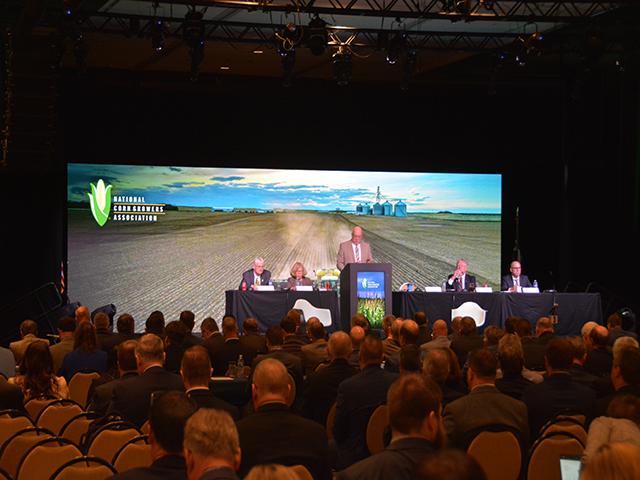At the Corn Congress meeting at Classic, delegates for the National Association of Corn Growers voted 73-51 to keep pressing Congress for a mandatory update of base acres. The vote stood despite arguments from some states that a mandatory base-acre update is not politically achievable. Last summer, NCGA kicked off the debate over base acres by calling for a one-time, national, mandatory update as part of the farm bill.
Arguing against a voluntary base-acre update, NCGA delegates said it would be too expensive. The only farmers who would actually update their base acres are the ones who don’t have any base or those who would benefit by flipping their base-acre crops to those more likely to generate an ARC or PLC payment.
“It all boils down to, if a voluntary update is going to be more expensive, it’s going to be tougher to get that one to go through,” said Minnesota farmer Tom Haag, chairman of NCGA. “It’s been over ten years since we had an update for farmers with base acres.
Haag said a mandatory update seems fairer and it allows those producers who do not have base acreage to become enrolled in the commodity programs.
“It seems like there’s more talk about the base acres than the reference prices,” Haag said. “We’d like to see the reference prices go up, but a lot of our delegates want to address the situation with base acres.”
SOYBEAN FARMERS
Base acres: 55.8 million
Average planted acres: 86.1 million
Effective reference price: $9.26 a bushel
The American Soybean Association has taken the position that there should be a voluntary base-acre update.
“Every farm is different and base-acre updates are different from farm to farm, they are different from state to state, region to region, and they are different from crop to crop,” said Josh Gackle, a North Dakota farmer and president of ASA.
ASA would like to see reference prices increased so they more accurately match the costs of production.
In the 2018-19 trade war, prices fell but did not get low enough to generate a PLC payment. The same scenario is happening now as prices fall, but not low enough to trigger payments.
“If ARC and PLC don’t trigger at those prices, it’s clear that there’s something wrong with the reference prices,” Gackle said. “But I think we all know that it’s going to take additional money.”
On Stabenow’s proposal, Gackle said ASA opposes choosing one or the other. “I think there is room for both increased reference prices and robust crop insurance and that’s what we’ve been prioritizing and what we will continue to pursue.”
WHEAT GROWERS
Base acres: 69.7 million
Average planted acres: 47.4 million
Effective reference price: $5.50 a bushel
The National Association of Wheat Growers (NAWG) opposes making changes to base acres in the farm bill, except for enrolling farmers who currently do not have any base acres, said Chandler Goule, CEO of NAWG.
“That’s quite a bit of money and we’re already in a money or revenue situation, or lack thereof, in this farm bill,” Goule said.
He added NAWG has made the group’s position clear to the “four corners” — the chairs and ranking members of the House and Senate agriculture committees. “We do not support adding a base-acre update to this particular farm bill.”
Goule said his members want to see any additional money go to help support reference prices, but that also includes a caveat. Any increase needs to be higher than simply a 10% bump — going from $5.50 to $6 a bushel for wheat. Goule said such an increase would need to be at least $1 a bushel or more.
“Then you’re getting into double-digit billions (of dollars), just for wheat alone,” Goule said. ” So, we need to be realistic with the limited amount of dollars in this bill. Where do we want to spend it? Maybe making crop insurance more affordable at higher coverage levels?”
NAWG doesn’t support having farmers choose between higher ARC-PLC levels or better crop insurance. If funding levels are tight, the group’s members would prefer focusing on making crop insurance more affordable.
“But we absolutely oppose having to pick between the commodity programs and crop insurance,” Goule said.
Chris Clayton can be reached at Chris.Clayton@dtn.com
Follow him on X, formerly known as Twitter, @ChrisClaytonDTN
(c) Copyright 2024 DTN, LLC. All rights reserved.




